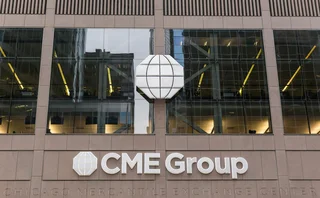
Energy vol puts spotlight on Ice’s TTF futures margin
Clearing firms say exchange was slow to react as natural gas prices spiked

Clearing brokers are scrutinising margin levels on a crucial natural futures contract after last week’s extraordinary price moves led to a handful of energy suppliers defaulting.
The Dutch TTF gas futures contract listed on Ice Endex in the Netherlands was undermargined, according to two risk sources at large clearing banks, who say the exchange ignored their calls to hike levels ahead of the moves.
“We asked them to put up their margin rates, and they weren’t willing,” says a risk manager at a large European clearing bank. “We told them that their margins were way too low, and I don’t think they even elevated to the extent we thought it should be.”
A source at a second clearing bank echoes those concerns, saying Ice had been “slow to react”.
The European natural gas benchmark, which tracks the price of one megawatt hour of power delivered via the Title Transfer Facility virtual trading point in the Netherlands, nearly doubled last month from €50.4 ($58.16) on September 1 to €97.8 ($112.85) on September 30.
The front-month November contract jumped another 20% from €96.7 on October 4 to €116 on October 5, with significant intraday swings. Ice’s margin rate of €16.5 for the contract over the period was lower than the daily moves, resulting in a contract level breach.
An executive at a third clearing firm is more forgiving of Ice’s margin lapse: “Margins on the futures side are not intended to cover the worst case, and for this particular product, this was just one of those large tail risks.”
Ice raised the margin rate for the contract from €11.4 on September 24 to €15.1 on September 25, and again to €16.5 on October 1. The margin rate stayed at this level until October 12, when it was bumped to €23.7. A subsequent hike on October 13 further increased margins to €27.5.
A spokesperson at Ice declined to comment.
We have seen some small defaults on small players that buy wholesale and sell retail
Risk manager at a large European clearing bank
TTF is the primary benchmark for European natural gas. Like its US counterpart, Henry Hub, the European contract acts as a pricing index for liquefied natural gas. A daily average of 224,310 TTF contracts traded in September. CME-listed Henry Hub natural gas futures, which have different contract specifications, saw an average of 496,000 contracts traded each day.
Some clearing brokers took matters into their own hands and called clients for additional margin when prices began surging in late September. The risk manager for the large European clearing bank says the firm increased margin requirements by 20–50% for directional energy portfolios – effectively pre-empting the margin hikes Ice implemented after prices jumped.
“It was a bit like oil going negative,” says the risk manager at the large European clearing bank, referring to the collapse in oil prices in April 2021. “We saw it coming, and you usually have a week or so to prepare. Nobody expected oil to go to minus 40, but we did expect it to go to zero or minus 10 or 15. Nobody expected gas prices to go through the roof now like they have, but everyone expected a spike.”
The fallout from last week’s price spike was relatively contained because many of the largest players in the natural gas market are hedgers that use futures to minimise exposure to price moves. These companies – including many of the largest energy suppliers – are typically charged the base exchange margin rate.
“A lot of the open interest in these contracts is controlled by firms that are basically hedging physical on the other side,” says the executive at the third clearing firm. “Given that a significant percentage of open interest is these types of firms, it is unlikely they will go under.”
Smaller energy suppliers, commodity trading firms and hedge funds are typically charged a significant margin multiplier, or margined using clearing firms’ in-house risk models. These firms faced the brunt of last week’s margin hikes.
The source at the second clearing bank says they charged some clients triple the exchange margin in preparation for defaults.
The additional margin collected by the clearing banks protected them from losses when a handful of small energy suppliers defaulted last week.
“We have seen some small defaults on small players that buy wholesale and sell retail, because they usually buy spot for a month and have a locked-in price for the retail side,” says the risk manager at the large European clearing bank.
The defaulting firms are understood to be small UK energy suppliers, although there have also been defaults elsewhere, including in Germany.
“It’s more of those clients that have gone down with these moves,” says the risk manager. “They don’t have the pricing power or liquidity to sit out the ride.”
The defaults did not result in losses for the bank, he adds.
In a report released on September 30, S&P Global Ratings identified 12 UK energy suppliers that went bust last month, including Green Energy Network, Hub energy, People’s Energy, PFP Energy and Utility Point. These companies relied on charging low prices, but failed to effectively hedge against rising wholesale prices, which they cannot pass on to consumers.
Analysts at S&P expect the ‘big four’ energy operators in the UK – Centrica, EDF, E.ON and Scottish Power – to weather the current turmoil because of their superior hedging strategies and access to liquidity.
Only users who have a paid subscription or are part of a corporate subscription are able to print or copy content.
To access these options, along with all other subscription benefits, please contact info@risk.net or view our subscription options here: http://subscriptions.risk.net/subscribe
You are currently unable to print this content. Please contact info@risk.net to find out more.
You are currently unable to copy this content. Please contact info@risk.net to find out more.
Copyright Infopro Digital Limited. All rights reserved.
As outlined in our terms and conditions, https://www.infopro-digital.com/terms-and-conditions/subscriptions/ (point 2.4), printing is limited to a single copy.
If you would like to purchase additional rights please email info@risk.net
Copyright Infopro Digital Limited. All rights reserved.
You may share this content using our article tools. As outlined in our terms and conditions, https://www.infopro-digital.com/terms-and-conditions/subscriptions/ (clause 2.4), an Authorised User may only make one copy of the materials for their own personal use. You must also comply with the restrictions in clause 2.5.
If you would like to purchase additional rights please email info@risk.net
More on Risk management
How a serverless risk engine transformed a digital bank
Migrating to the cloud permitted scalability, faster model updates and a better team structure
During Trump turbulence, value-at-risk may go pop
Trading risk models have been trained in quiet markets, and volatility is now looming
Osttra to launch Treasury clearing middleware
Mid-year delivery expected for system that aids credit checking for repo trades
Banks divided over CME’s done-away model for UST clearing
Buy side could give thumbs-up if questions on margin protection and guarantee fees are answered
Why JP Morgan’s Santos wants to make bad news travel fast
Asset management CRO says sharing information early holds the key to avoiding surprises
Mitigating model risk in AI
Advancing a model risk management framework for AI/machine learning models at financial institutions
BoE warns over risk of system-wide cyber attack
Senior policy official Carolyn Wilkins also expresses concern over global fragmentation of bank regulation
Treasury clearing timeline ‘too aggressive’ says BofA rates head
Sifma gears up for extension talks with incoming SEC and Treasury officials







